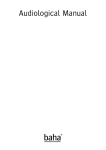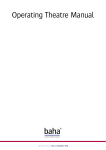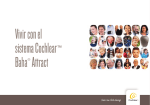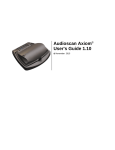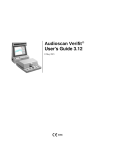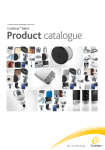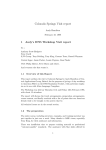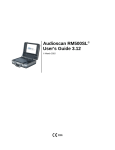Download Fitting Guide - For professionals
Transcript
FOR Professionals A Bone Conduction Hearing Solution Fitting Guide Fitting Guide Fitting Guide Contents 5Introduction 6 PART 1: Inspection of the abutment area 7 PART 2: Connecting the sound processor 8 PART 3: Fitting 12 PART 4: Using the sound processor 15 PART 5: Caring for the abutment and sound processor 18 PART 6: Troubleshooting 22 PART 7: Accessories 25 PART 8: Patient kit and documents 28 PART 9: Follow-up 29 PART 10: Pediatric fitting with Baha® Softband 33References Products in this manual are protected by the following patents: US 5 735 790, US 5 935 170, EP 0715839, EP 0715838 and corresponding patents in other countries and pending patent applications. No part of this publications may be replaced, stored in a retrieval system, or transmitted in any form, by electronic, mechanical, photocopying, recording, or other means, without the prior consent of the publisher. 34Notes Caution: Federal law (USA) restricts this device to sale by or on the order of a medical practitioner. © Cochlear 2011. All rights reserved. 2 3 Introduction Introduction Introduction This guide covers the steps required for the successful fitting of a Baha® Sound Processor for both adult and pediatric patients. It also provides information on the aftercare required and the accessories that are available for the Cochlear™ Baha® 3 System. Each part of the fitting process included in this guide should be covered during a fitting session. Demonstrating care of the implant site and care and use of the sound processor are of particular importance. However, the order of the steps involved in the fitting process can be modified to suit individual preferences. The Fitting Guide is part of a range of Baha audiology documents designed to guide you through the process of identifying patients, selecting a suitable sound processor for patients, fitting the chosen device and providing follow-up support. 4 5 PART 1: Inspection of the abutment area PART 2: Connecting the sound processor PART 1 Inspection of the abutment area 1. Try rotating the abutment to check that it is stable. If the abutment connection seems loose, refer the patient to a trained healthcare professional to have it tightened. 2. Inspect the skin around the abutment before the sound processor is connected. 1 3. A ny skin debris from around the base of the abutment should be removed. This prevents infections. Skin debris may be found inside the abutment itself, and this should also be removed. Should there be any sign of a skin irritation around the abutment area, apply a mild antibiotic cream/ointment. The clinic should provide counseling to the patient on how to treat skin reactions and which ointments to use. Make it clear that, should soreness persist, the patient must contact the clinic. PART 2 Connecting the sound processor Training with the snap trainer Use a “dummy” sound processor for this training to avoid damaging the patient’s sound processor. Have the patient practice connecting and disconnecting the sound processor to a snap trainer to avoid damage to the snap coupling. Instructions for the patient 1. H old the sound processor so that the snap coupling is accessible. Tilt and push the unit carefully in and it will connect to the abutment on the snap trainer. 1 2. To release the sound processor, put one finger under the device and tilt it until it releases. 2 2 Training on the patient’s abutment When the patient is comfortable with the tilt technique, have the patient practice connecting and disconnecting the sound processor on their own abutment. 3 Instructions for the patient 1. Move any stray hair away from the abutment. 2. Use the same technique that you practiced with the snap trainer to tilt and push the device on to your abutment. 1 2 3. T o release the sound processor, put one finger under the device and tilt it until it releases. Important! Use the tilt technique to avoid pushing the sound processor straight in or out. This reduces pressure on the snap coupling and abutment, preventing any discomfort. 3 6 7 PART 3: Fitting PART 3: Fitting Stand-alone Mode PART 3 Fitting 1. Start the Cochlear Baha Fitting Software by double-clicking the icon on your desktop or from the Start menu. 2. Connect the sound processor to the NOAHlink or HI-PRO USB box and then to the patient’s abutment. Initial settings STEP 1 Patient > Audiogram The new generation Baha® 3 Sound Processors are programmable. The factory setting may be a starting point for a quick demonstration in some cases but it is suggested that a processor is custom programmed using Baha Fitting Software for optimized performance. Once the sound processor is programmed (please see page 9), further evaluate patient feedback on sound quality and fine tune the processor using the Hearing Mentor feature of the Baha Fitting Software. Enter the patient’s personal data and thresholds in the audiogram or click the Import button to import the patient’s personal information and audiogram data from where you have the data stored on your computer. STEP 2 Sound Processor Select sound processor and press the Detect button: STEP 3 BC Select Basic programming steps for Baha 3 (BP100) and Baha 3 Power (BP110) Programmable Sound Processors Program the Cochlear™ Baha Sound Processor using the Cochlear Baha Fitting Software. Launch this software from NOAH or start it directly in stand-alone mode. Before launching the software, install it on a computer as described in the Installation Instructions. To match the patient’s individual profile, be sure to choose parameters that best describe your patient in each of the following items: 1. Patient 2. Indication 3. Connection STEP 4 Fitting (recommended) Make adjustments to match the patient’s needs: (a) BC Direct — Measure the patient’s bone conduction responses directly through the sound processor. (b) Hearing Mentor — Make adjustments to meet individual patient needs. STEP 5 Finalize > Save Click the Save button to download settings to the sound processor. You also have the option to click the Export button to export the patient’s personal information and audiogram data to where you would like to save it on your computer. If needed, click Session Report for a printable PDF document that includes useful information for both the patient and the clinician. NOAH 1. Start NOAH. 2. Select or add a patient in NOAH. For a returning patient, select a session. 3. If needed, enter hearing thresholds in the audiogram. 4. Click the NOAH module selection button and choose Cochlear Baha Fitting Software. 5. Connect the sound processor to the NOAHlink or HI-PRO USB box and then to the patient’s abutment. STEP 3 Fitting (recommended) Make adjustments to match the patient’s needs: (a) BC Direct — Measure the patient’s bone conduction responses directly through the sound processor. (b)Hearing Mentor — Make adjustments to meet individual patient needs. STEP 2 BC Select To match the patient’s individual profile, be sure to choose parameters that best describe your patient in each of the following items: 1. Patient 2. Indication 3. Connection 8 1. Upon completion of initial fitting using Baha Fitting Sofware, let the patient keep the processor connected to his/her abutment. Hearing Mentor task lets you quickly and easily make overall changes to the sound processor for the typical patient comments. 2. Ensure the processor is on and connected to the computer hosting the Baha Fitting Software through the programming cable. • Loudness — Adjusts overall loudness of the chosen program in the patient’s sound processor. STEP 4 Finalize > Save 3. Click on the menu “Hearing Mentor” in the Baha Fitting Software. Click the Save button. If needed, click Session Report for a printable PDF document that includes useful information for both the patient and the clinician. 4. Have the patient describe the sound quality: Is it too loud/soft? What about the patient’s own voice? Is their voice too low or too high pitched? • Sound Quality — For a brighter sound with high frequency emphasis, increase the setting. For a fuller sound with a flatter frequency response, decrease the setting. STEP 1 Sound Processor Select sound processor and press the Detect button: Evaluation by the patient 5. Adjust the slider controls according to the patient’s comments on sound quality in the “Hearing Mentor” screen. 6. Repeat step 4 and 5 until the patient is satisfied with the sound. • Own Voice — Increase or decrease to make the patient’s voice louder or softer. • Performance in Noise — For a clearer sound with greater emphasis on softer high frequency speech sounds in a noisy environment, increase this setting. For a more comfortable sound with less high frequency emphasis, decrease this setting. 9 PART 3: Fitting PART 3: Fitting Alternate fitting option: Button programming for Cochlear™ Baha® 3 Sound Processors Fine tunning for Cochlear Baha Cordelle II Sound Processor Please note that the steps below occur sequentially, i.e., in order to perform step 4, steps 1-3 must be completed first. Note: If the sound processor has been programmed using the Baha Fitting Software, adjustments made using Button Programming will be cumulative. Initial settings STEP 1 Activating programming mode Button programming tool Program Press (preferably using the tool) the Volume buttons and the Program button at the same time and hold for three seconds. The orange and blue indicators will then emit a long flash followed by a series of short, alternating flashes to indicate that programming mode is active. STEP 2 Make sure the sound processor is set to the following initial settings: LB Minimum, TK Maximum, Tone = N and Telecoil in the M position. The TK trimmer will adjust the gain for soft sounds and the LB trimmer will adjust loud sounds. 3 SEC Program • Press left — to select the left side — the blue indicator illuminates • Press right — to select the right side — the orange indicator illuminates STEP 3 Left Right - + Program Default Low cut Program Activating or disabling visual indicators TK LB TK Too much bass/problem with own voice N H L Too much treble To save the indicator status or to move on to the next step, press the Program button. Five long flashes are followed by a series of short, alternating flashes. OFF Exiting the programming mode Let the patient adjust the volume to the most comfortable level. If the sound is still perceived as loud, repeat this step. Ask the patient what kind of sounds (soft or loud sounds) are too loud and then adjust the respective trimmer. Set the tone control to H. · Press left — turns off the visual indicators — the orange indicator illuminates · Press right — turns on the visual indicators — the blue indicator illuminates STEP 6 LB Check the volume. Decrease the LB. If soft sounds become too low, increase the TK slightly. · Press left — sets the default frequency response — the orange and blue indicator illuminate · Press right — sets low cut — orange indicator illuminates STEP 5 Telecoil selector M = Microphone MT = Microphone and telecoil T = Telecoil Sound too loud Adjusting the low cut setting To save your setting or to move on to the next step, press the Program button. Four long flashes are followed by a series of short, alternating flashes. Tone selector N = Normal H = High frequency emphasis L = Low frequency emphasis Program · Press left — decreases the gain 5dB — the blue indicator illuminates · Press right — increases the gain 5dB — the orange indicator illuminates · Press left and right – returns to the default setting – the blue/orange indicators illuminate STEP 4 TK Maximum Increase the LB slightly. If feedback occurs or the patient feels that soft sounds are too loud, decrease the TK slightly. Let the patient adjust the volume to the most comfortable level. If the sound is still perceived as weak, repeat this step. Ask the patient what kind of sounds (soft or loud sounds) are too low and then adjust the respective trimmer. Adjusting gain (by +/- 5dB) To save your selection or to move on to the next step, press the Program button. Three long flashes are followed by a series of short, alternating flashes. LB Minimum Sound too weak Volume Selecting the left or right side To save your selected side or to move on to the next step, press the Program button. Two long flashes are followed by a series of short, alternating flashes. Trimmers LB = Loudness boost TK = Threshold knee Set the tone control to L. For more information on the effect of the tone switch, see the Baha Cordelle II data sheet. ON Program Press (preferably using the tool) all three buttons and hold for three seconds. The indicators will stop flashing. 10 *The illustrations used for describing the process of Button Programming, applies to both the Cochlear Baha 3 (BP100) and Cochlear Baha 3 Power (BP110) processors. N H L 3 SEC 11 PART 4: Using the sound processor PART 5: Care of the abutment and sound processor PART 4 Using the sound processor Part 4-8 (pages 12-27) are particularly important for the patient. Going through these parts carefully will help ensure that patients get the maximum benefit from Baha®. Many of the points covered in part 4-8 are included in the Patient User Manual. Using the manual to review these steps will familiarize the patient with the document. BP100 BP110 Power 1 1. Demonstrate how to use the volume control, including switching the device on and off. Explain that moving the volume control wheel from position 0 to 1 or vice- versa turns the sound processor on or off, in a non programmable processor. In a programmable processor, LEDs flash to confirm when the processor turns on. PART 5 Care of the abutment and sound processor Regular aftercare is needed for the abutment area, the inside of the abutment and the sound processor. This care is crucial to the best outcomes for the patient. It is important that the patient understands the need for aftercare and can comply to the requirements needed to maintain their Baha 3 System. 2. Review all the available programs and how they should be used. Changing Program: A Baha 3 Sound Processor can hold up to 3 programs. To switch programs, quickly press and release the middle button. Audio and visual signals let you know which program you have switched to. 3. Show how to connect accessories to the sound processor. BP100 BP110 Power 2 4. Explain how to change the battery and where the patient can obtain new batteries for the sound processor. 5. Describe the different factors that can affect battery life. Recommend that the patient uses powerful batteries when high current consumption is common. The batteries delivered with the sound processor reflect the Cochlear™ latest battery recommendations. Factors affecting battery life: • Hours of use per day • Program setting • Volume setting 3 • Sound environment • Battery brand • Use of an FM receiver Note: If the patient connects an FM receiver, battery life will decrease, even when the device is switched off, as the FM receiver uses the sound processor as its power source. 4 12 13 PART 5: Care of the abutment and sound processor PART 5: Care of the abutment and sound processor First weeks Weekly cleaning During the first weeks after surgery, once the dressing is removed, cleaning the abutment with the abutment cleaning brush may feel a little rough for the patient. A strip of alcohol-free wet wipe can be used around the abutment until the skin becomes less sensitive and the brush can be used. 1. Explain that the patient should clean the inside of the abutment on a weekly basis. If the inside of the abutment is not clean it can prevent a smooth fitting of the Baha Sound Processor onto the abutment and can also affect the sound quality. Daily cleaning Explain that the abutment area must be cleaned on a daily basis in order to keep it reaction-free. Skin debris may build-up around and inside the abutment and it is important that it is removed. Demonstrate to the patient how to use the abutment cleaning brush to keep the abutment area clean. Instructions for the patient 1. Bristles should be aimed at the side of the abutment rather than at the skin. The focus is to remove crust and debris from the base of the abutment rather than on brushing the skin. You can demonstrate the proper cleaning brush technique using the snap trainer. 2. Using a mild soap with plenty of warm water is recommended. Cleaning the abutment is commonly done in conjunction with taking a shower or a bath. 2. Describe how to keep the sound processor clean by wiping it regularly with an alcohol free wipe. 3. Make sure the patient knows that the snap coupling of the sound processor must always be kept visibly clean. Use the sound processor brush to clean the snap coupling. Do not use water when cleaning the sound processor. 1 4. Suggest that a relative or friend can help the patient make regular visual checks around the abutment for signs of infection as there may be parts of the abutment area that are hard for the patient to see for themselves. 5. If the patient does not want to involve anyone else in the care of the abutment, they could use a mirror to check the site. If it is hard to see all angles in the mirror, a digital camera can be used to take pictures of the abutment. Using the pictures the site can be seen from all angles. 2 Note: Inform the patient that the snap coupling is a sensitive part of the sound processor. Patients should not put excessive force on the snap coupling during cleaning as this may damage the sound processor. All of these items are available in the Baha Aftercare Kit. 3 14 15 PART 5: Care of the abutment and sound processor PART 5: Care of the abutment and sound processor Cleaning brushes Signs of problems 1. Advise the patient that the sound processor brush (1) (for snap coupling) and the abutment cleaning brush (2) (for abutment and surrounding area) should be cleaned each time they are used. When the patient has finished with the brush, it should be rinsed in soap and water, and left upright to dry. The brushes should also be changed at regular intervals (Cochlear™ recommends every 3 months). Instruct the patient to clean the skin and apply a mild antibiotic cream/ointment if any redness and/or soreness should occur around the abutment. Additional instruction may be required on how to properly treat skin reactions, and which ointments should be used. 2. Explain to the patient that it is also important that different brushes are used for cleaning the abutment and the snap coupling respectively. If the patient is bilaterally fitted, different brushes should be used for each side. Make it clear that, should redness and/or soreness persist, the patient must contact the clinic. If in any doubt, the patient should always contact the clinic. A skin reaction is easier to treat at an early stage; once it becomes an infection it will require more care. 1 Note: Water should not be used when cleaning the sound processor. Should you require any additional information on the cleaning of devices, please contact your local Cochlear office. 2 16 Note: Cochlear does not recommend using a standard toothbrush for the cleaning of the abutment area as it may be too abrasive. Please use a an abutment cleaning brush as supplied with the Baha® Sound Processor. 17 PART 6: Troubleshooting PART 6: Troubleshooting PART 6 Troubleshooting No sound/weak sound Buttons not working • Weak or dead battery — try a new battery • • In DAI program — try a different program Keylock enabled Visual Indicator will flash 6x on start-up: Blue indicator gives three short flashes Orange indicator gives three short flashes • Volume too low — increase volume • Clogged microphone cover — change battery door • Programming mode enabled — if the LEDs are flashing alternatively, remove battery to reset device • Activating keylocks Press the two volume buttons at the same time and hold for five seconds. Blue indicator gives three short flashes. • Deactivating keylocks Press the two volume buttons at the same time and hold for five seconds. Orange indicator gives three short flashes. Note: Programming adjustment should not be performed by the patient. Distorted/intermittent sound • Volume is set too high — decrease volume setting • Weak or dead battery — try a new battery • Battery door not closed completely — use instructions in the user manual to close the battery door properly • Battery door damaged — replace battery door • Loose abutment — tighten abutment • Programming adjustments may be needed Note: Abutment tightening should be performed by authorized professional only. Programming adjustment should not be performed by the patient. 18 19 PART 6: Troubleshooting PART 6: Troubleshooting Feedback If the sound processor has become damp/wet • Battery door in the wrong position 1. Immediately open the battery door and remove the battery. • Objects in contact with sound processor 2. Put the sound processor in a container with drying capsules. Leave the device to dry out overnight. Drying kits are available from most hearing healthcare professionals. • Volume is set too high • Battery door damaged • Programming adjustments may be needed Note: The sound processor is not waterproof! Instruct the patient not the get the sound processor wet! Note: Programming adjustment should not be performed by the patient. Should any problem persist after the recommended actions have been taken, return the device to your local Cochlear™ office for repair/inspection. 1 20 21 PART 7: Accessories PART 7: Accessories PART 7 Accessories A number of accessories have been developed for Baha® Sound Processors. The accessories are designed to maximize access to technologies that make listening easier in specific environments. Specify which accessories are available; discuss how they are used and how the accessories meet the patient’s possible needs. Audio adapter The audio adapter allows direct input from personal stereos, TVs, MP3 players and other external audio equipment. The audio adapter also works as an isolator, protecting the sound processor from sudden power peaks. For Cordelle II, Intenso™, Divino™, Compact Processors Warning! It is extremely dangerous and potentially fatal to connect any equipment that is plugged into a 110 and/or 220 V power supply without using the Audio adapter. Only connection cables supplied by Cochlear should be used. Non-standard connection cables can cause damage to the sound processor and injury to the patient. Cochlear is not liable for any damage resulting from incorrect use or connecting incorrect equipment. For Baha 3 Processors FM-receiver FM systems are primarily used in the classroom and other settings where there is a primary speaker that needs to be heard clearly in spite of background noise. There are various FM receivers that are compatible with Cochlear™ Baha Sound Processors. For Intenso, Divino, Compact Processors For Baha 3 Processors Telecoil unit The telecoil unit is specifically designed to improve sound when using telephones. In addition, it enables access to loop facilities in homes and public buildings with the head worn devices. Body worn devices have a built-in telecoil. For Intenso, Divino, Compact Processors For Baha 3 Processors 22 23 PART 7: Accessories PART 8: Patient kit and documents PART 8 Patient kit and documents Bluetooth® accessories Bluetooth accessories allow wireless connection between a Baha and a Bluetooth compatible device such as a cell phone. Bluetooth accessories are connected to the Baha® Sound Processor by using a telecoil and the neck-loop provided with the Bluetooth accessory. Note: Cochlear™ recommends testing any Bluetooth device with the Baha Sound Processor and the patient’s mobile phone before purchase, as the signal strength and sound quality differ between mobile phones. Cochlear™ Baha Sound Processors are delivered in a kit that includes useful components and important documentation. The kit includes: abutment cover, safety line, soft cleaning brush, Share the Experience (test rod), Patient User Manual, Device Registration Card and Warranty Card and a pack of recommended batteries. Introducing the kit and its contents will help ensure your patient gets the maximum benefit from their Baha. Connection 1. Explain that all accessories plug into the Direct Audio Input (DAI) on the sound processors. 2. Explain that accessories must be correctly connected to the sound processor. Instructions for the patient A. Accessories for the new Baha 3 Sound Processors use a 3 pin connector. One of the 3 pins are thicker than the others. The thicker pin should be aligned with the thicker hole in the processor before connecting an accessory. B. The telecoil and the audio adapter for the older Baha Sound Processors are marked with a red dot/mark beside one of the pin plugs. On the sound processor there is a corresponding mark beside one of the three DAI holes. C. The marks on the sound processor and the marks on the telecoil/audio adapter must match up when connecting. 24 25 PART 8: Patient kit and documentation PART 8: Patient kit and documentation Patient kit Abutment cover An abutment cover is included in the kit. It can be attached when the device is not being worn. It counteracts reflection of light from the abutment and keeps the inside of the abutment clean. The patient should use the abutment cover during hair treatments such as coloring. Safety line The safety line prevents the sound processor from being lost if it is inadvertently knocked off, for example during sporting activities. Cochlear™ recommends that children wear the safety line at all times. The safety line is also considered useful for new users. Share the Experience A modified test rod is delivered along with the Baha® Sound Processor. The purpose of the test rod is to encourage the patient’s relatives and friends to share the experience of bone conducted hearing. It is also useful for checking that a child’s sound processor is working. Demonstrate using the test rod First, snap the patient’s sound processor onto the test rod using the same tilting motion that is used when attaching the processor to their abutment. Then hold the test rod firmly against the skull bone behind the ear without touching the sound processor housing. Have the person listening to the Baha plug their ears so they can fully appreciate the sound. Documentation Abutment cleaning brush The abutment cleaning brush included in the kit is important for aftercare. Read more about it under Caring for the abutment and sound processor (see page 13-17). Inform the patient where new brushes can be purchased. Patient User Manual Go through the Patient User Manual together with the patient. Device Registration Card Fill in the Device Registration Card together with the patient and send this to Cochlear. Warranty, service and repair Explain warranties. Warranties for Baha differ from country to country. For information about the warranty in your country please consult your local Cochlear office. The requirement for service and repair of the sound processor depends on the patient’s use of the device, as well as hygiene and the environment. Make sure that the patient is aware of how the sound processor should be used and maintained. 26 27 PART 9: Follow-up PART 9 Follow-up Cochlear™ recommends scheduling a follow-up appointment with the patient within 6 weeks after initial fitting for evaluation and final adjustment of the sound processor. It is very important to make a new adjustment of the settings once the patient has become accustomed to the sound of the Baha® device. 28 PART 10: Pediatric fitting with Baha Softband PART 10 Pediatric fitting with Baha Softband Pediatric fittings are particularly challenging because the results can often be difficult to verify. When using a Baha Softband the sound signal from a Baha device is reduced by approximately 10 dB 1, compared to the sound from a device fitted to an osseointegrated implant. Therefore, Cochlear recommends that you use a stronger sound processor for the test than the child’s audiogram indicates. This will have a greater impact on the higher frequencies. High frequencies are weakened by passing through skin more than low frequency signals.1–2 The new Baha Fitting Software offers features such as BC Select and BC Direct that may help in best optimizing a Baha 3 Sound Processor fitting with Baha Softband. 29 PART 10: Pediatric fitting with Baha Softband PART 10: Pediatric fitting with Baha Softband Fitting the Baha Softband ® Try to make the first moments with the Baha Softband as pleasant for the child as possible. It is very important that the child has positive associations with using the Baha Softband. 8. Make sure the sound processor does not touch the auricle or have any other contact with the skin, to prevent feedback. 1. Program the sound processor for patient’s individual bone line using the Baha Fitting software. Optimize the sound processor fitting for use with Baha Softband by selecting suitable parameters in the BC Select screen. Also, whenever possible, conduct BC Direct measurements, which are in-situ bone conduction thresholds, using patient’s processor. 9. Present some noise and observe the child. Verify that there is adequate gain via soundfield audiometry or other age-appropriate testing. 2. Attach the sound processor to the plastic snap connector disc on the Baha Softband. 10. If necessary increase the volume, monitoring the child to check that the sound is not too loud. 2 8 Note: The amount of sound that gets transferred is based on both the volume setting and the contact area of the plastic snap connector disc. 3. Test that the Baha Softband works by putting it on yourself, plugging your ears and introducing sound. 4. Put the Baha Softband around the child’s head, quite loosely at first. 5. Place the plastic snap connector disc against the mastoid or another bony location of the skull. Avoid placing it on the temple, as this may be uncomfortable. 6. Check that the entire snap connector disc is in contact with the skull bone. 7. Tighten the Baha Softband until it is close-fitting enough to ensure effective sound transmission but loose enough not to cause the child any discomfort. 3 9 Tip: Make sure your finger fits between the skull and Baha Softband – this will ensure that the Baha Softband is not too tight. Note: Once the Baha Softband is tight enough to transmit sound effectively, additional tightening will only increase the sound marginally.3 4 Caution: The older Baha Softbands contain natural rubber latex that may cause allergic reactions. The newer generation Baha Softbands are latex free. 5 30 31 References PART 10: Pediatric fitting with Baha Softband Period of use 1. Keep the Baha® Softband on for very short periods (10 –15 minutes) for the first few occasions. 2. Use for longer periods once the child accepts the Baha Softband. 3. Rotate the position of the plastic snap connector disc regularly. Pediatric considerations For children who have been fitted with a Baha on an implant or with a Softband, it is important that the parent or caregiver help with inspection, cleaning and maintenance of the abutment area, Softband and sound processor. Provide the parents or caregivers with the following information. • Demonstrate the sound processor using the test rod. 4. Reduce the time of use if there is any sign of discomfort. This is to ensure that the child maintains positive associations with using the Baha Softband. • Review care and maintenance of the abutment area and the sound processor. • Go through troubleshooting the sound processor. Note: Cochlear recommends rotating the position of the plastic snap connector disc regularly to avoid discomfort and soreness. If soreness arises, avoid placing the plastic snap connector disc on this area for a couple of days. Should the soreness persist, discontinue use of the Baha Softband for a couple of days or until the soreness is gone. Safety line • Advise the parent/caregiver that the test rod or Baha Softband can also be used to check that the sound processor is working properly. A demonstration may be needed. Note: The Baha Softband can also be used by older children who are contraindicated for surgery. Important! Cochlear™ recommends that the safety line is used to attach the device securely to the child’s clothing. Note: Ensure that infants have adult supervision when wearing the Baha Softband. References 1. B. Håkansson, A. Tjellström, U. Rosenhall, Hearing thresholds with direct bone conduction versus conventional bone conduction. Scandinavian Audiology 1984;13(1):3-13. 2. Gründer I, Seidl RO, Ernst A, Todt I. Relative value of Baha testing for the postoperative audiological outcome. HNO 2007 Sep 20. 3. Hodgetts WE, Scollie SD, Swain R. Effect of applied contact force and volume control setting on output force levels of the Baha Softband. Int J Audiol. 2006;45(5):301-8. 32 33 Notes Notes 34 Notes Notes 35 This is the Cochlear ™ promise to you. As the global leader in hearing solutions, Cochlear is dedicated to bringing the gift of sound to people all over the world. With our hearing solutions, Cochlear has reconnected over 250,000 cochlear implant and Baha® recipients to their families, friends and communities in more than 100 countries. Along with the industry’s largest investment in research and development, we continue to partner with leading international researchers and hearing professionals, ensuring that we are at the forefront in the science of hearing. For patients receiving any Cochlear hearing system, our commitment is that for the rest of your life we will be here to support you. As your patient’s partner in hearing for life, Cochlear believes it is important to convey not only the benefits, but also the potential risks associated with a Baha procedure. Not everyone with hearing loss is a candidate for a Baha. Baha is contraindicated in patients with inadequate bone quality or quantity to provide stability and support for the implant, or in patients who will be unable to maintain and clean the skin around the abutment. In the U.S., use of the implanted fixture is also contraindicated in children under age 5 years. All surgical procedures include an element of risk, and it is impossible to guarantee success. The device may fail to osseointegrate for a number of reasons, including physiological and surgical issues as well as traumatic impact to the implant site. On rare occasions the skin around the abutment may become inflamed from a mild infection or the skin may grow back towards its original thickness. For complete information regarding the risks and benefits of a Baha procedure, please refer to the instructions for use for the Baha implant available at ww.CochlearAmericas.com/Bahaindications www.CochlearAmericas.com Cochlear Americas 13059 East Peakview Avenue Centennial CO 80111 USA Tel: 1 303 790 9010 Fax: 1 303 792 9025 Cochlear Canada Inc 2500-120 Adelaide Street West Toronto, ON M5H 1T1 Canada Tel: 1 416 972 5082 Fax: 1 416 972 5083 Baha, Baha Divino and Baha Intenso are trademarks of Cochlear Bone Anchored Solutions. Cochlear and the elliptical logo are trademarks of Cochlear Limited. The names of actual companies and products mentioned herein may be the trademarks of their respective owners. © Cochlear Bone Anchored Solutions 2011. BUN027 ISS1 DEC11



















